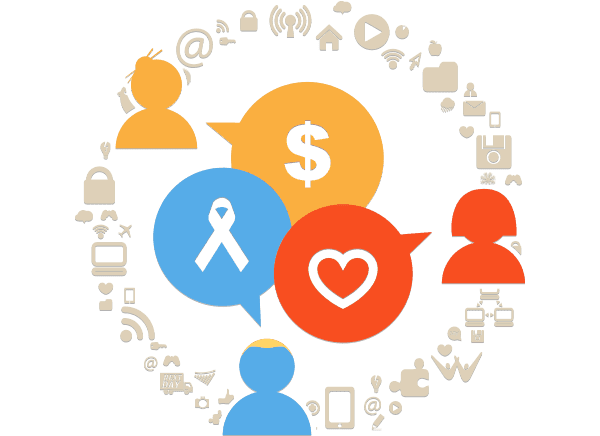How to Effectively Integrate Social Media & Fundraising
Social media continues to revolutionize how we interact with the world (especially the digital one) and the people around us. But while many nonprofits integrate social media & their fundraising strategy, few employ the following tactics that give their online presence a boost.
First, some fast facts for you. Social media is the number one reason people in the US use the Internet. What’s more, 55% of your followers are more likely to take action with your organization if you engage them online. They may donate, volunteer, or attend events.
But first, they crave interaction, stimulation, and a sense that the conversation is evolving. That’s where you come in.
Join the Conversation
Here at iWave, we work with many prospect researchers and fundraisers. Depending on the size of your organization, you may control all the social media output on an ad hoc basis. Or, maybe there is a dedicated social media coordinator. Even if you don’t post on behalf of your organization, there is no reason why you can’t join the conversation from your private account. We’re betting you’re already on Facebook, Twitter, Instagram, or all of the above. In fact, we have some of our best online conversations with researchers and fundraisers using the hashtags #prospectresearch and #fundraising.
Follow your organization and interact with it. Share their content and get the word out. It really is as easy as clicking a button. If you’re interested in more giving trends and ways to take action on them, check out this Giving Tuesday 2017 infographic.
Ask For Donations From Your Social Media Followers
Here’s a no-brainer: one way to leverage social media for fundraising efforts is to simply ask your followers for donations. If you’re unsure how the public will perceive such efforts, consider this: donors aged 40-59 (those are late Boomers and early Gen Xers) are now the most likely to give online. In 2010, 47% of this group donated online. Contrast that with 2015, when 67% said they donated online.
The key here is to be tasteful and transparent. It helps if you have a specific goal in mind. Explain your latest cause. Maybe you are renovating a wing of your hospital, or maybe a historic monument is in desperate need of restoration. Be clear, action-oriented, and use professional language. Let your followers know what you’re up to, and involve them. Finally, ask for help in the form of donations, or even just to share your post. You’ll be surprised at how fast word gets out, and how many followers lend a helping hand.
Promote Corporate Giving Programs
This is a great idea, and it comes from Kanwei Li’s guest post on Jennifer Filla’s blog.
“Some of your biggest supporters may work for companies that will reward their gifts of money and time with matching gift programs and volunteer grant initiatives. But your donors and volunteers might not know these programs exist at their jobs!”
– Kanwei Li, CTO of Double the Donation
This is where a prospect research tool fits in with social media fundraising. Using datasets like Dun and Bradstreet and Thomson Reuters, you can see where your donors and volunteers work. Then, in the Matching Gifts tab, you can determine which of those companies offer matching gift programs. Armed with that information, you can promote these programs within your social media posts.
Connect, Grow, Reconnect
 Did you know your social media presence should be growing at a rate of 23% per year? That seems low at first glance, but increasing your number of followers organically can take a long time. It’s especially difficult to grow your social media audience if you don’t engage your followers.
Did you know your social media presence should be growing at a rate of 23% per year? That seems low at first glance, but increasing your number of followers organically can take a long time. It’s especially difficult to grow your social media audience if you don’t engage your followers.
Engagement is especially critical for your donors, whether they are first-time givers of a small amount, or whether they are major gift donors. Follow these steps:
- First, prioritize a list of your donors with your prospect research tool.
- From this list, find your donors on social media and connect with them.
- Now look for the suggested lists of followers – connect with them too!
- Share content about your mission goals, fundraising calls to action, mission progress, and even your donor’s stories (remember to get their permission first).
- Thank your donors publicly with mass-audience posts, or with private, personalized messages.
If you take the first step to follow a donor or prospect, they will be much more likely to engage with you.
Just like people, each organization has a distinct personality. Social media is an excellent platform for showcasing your organization’s individuality. It’s also powerful in bringing people together and inspiring feelings of community and moving forward together.
As researchers and fundraisers, you may be able to gain insight about your prospects or even solicit gifts via social media. But as a whole, it’s about having a conversation with the people you support, and the people who support you.
[divider type=”e.g. 1, 2″ width=”e.g. small, medium, wide”][/divider]
 About the author: Ryan McCarvill joined the iWave team in 2016. Ryan enjoys meeting and learning from nonprofit professionals, researching trends in the nonprofit community, and offering strategies for development teams to use iWave’s solutions to meet and exceed their fundraising goals.
About the author: Ryan McCarvill joined the iWave team in 2016. Ryan enjoys meeting and learning from nonprofit professionals, researching trends in the nonprofit community, and offering strategies for development teams to use iWave’s solutions to meet and exceed their fundraising goals.
Want to get in touch with us? Check out iWave on Twitter, LinkedIn, Facebook, and Instagram.
Or want to get started prioritizing your donor list? Start here.
Stay Up-to-date on Fundraising News and Resources
